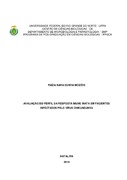Please use this identifier to cite or link to this item:
https://repositorio.ufrn.br/handle/123456789/25525| Title: | Avaliação do perfil da resposta imune inata em pacientes infectados pelo vírus Chikungunya |
| Authors: | Moizeis, Raíza Nara Cunha |
| Advisor: | Fernandes, José Verissimo |
| Keywords: | Chikungunya;Imunidade inata;Receptores;Citocinas;Infecção aguda |
| Issue Date: | 6-Apr-2018 |
| Citation: | MOIZEIS, Raíza Nara Cunha. Avaliação do perfil da resposta imune inata em pacientes infectados pelo vírus Chikungunya. 2018. 65f. Dissertação (Mestrado em Ciências Biológicas) - Centro de Biociências, Universidade Federal do Rio Grande do Norte, Natal, 2018. |
| Portuguese Abstract: | A infecção pelo vírus Chikungunya causa alta morbidade devido principalmente a artralgia e artrite geradas. A inflamação induzida nas articulações pela infecção viral envolve a imunidade inata e adaptativa. Entretanto, os mecanismos imunológicos envolvidos na proteção ou patogênese não estão ainda, totalmente, elucidados. Dessa forma o objetivo do presente estudo foi avaliar as expressões de receptores da imunidade inata e citocinas induzidas por sua ativação em pacientes infectados pelo vírus Chikungunya. Neste estudo, foi avaliado a expressão de RNAm por PCR em tempo real dos receptores tipo Toll (TLR3, TLR7, TLR8, TLR9), RLR (MDA5 e RIG-1), Moléculas adaptadoras (TRIF e MyD88) e citocinas (IFNα, IFNβ, IFNγ, IL-6, IL-12 e TNFα) em sangue total de pacientes na fase aguda da infecção por Chikungunya (N=28) e em indivíduos saudáveis, não infectados (N=9) utilizados como grupo controle. Os pacientes infectados pelo CHIKV apresentaram aumento da expressão de RNAm de TLR3, em relação aos indivíduos saudáveis. Não foi observada diferença significativa da expressão de TLR7, TLR9, MDA5 e RIG-1 nos pacientes infectados pelo CHIKV, sendo observada, no entanto, uma redução da expressão de RNAm de TLR8, quando comparado aos indivíduos saudáveis. Nossos resultados indicam que a infecção pelo CHIKV em pacientes na fase aguda induz elevada produção de IFN-α, IFN-γ e IL-6, moléculas da imunidade inata, com ação antiviral provavelmente, devido ao reconhecimento do vírus por TLR3 e em menor proporção por MDA5 e RIG-1, além de mecanismos que, possivelmente, envolvam a colaboração de TLR9. Ainda, foram constatadas correlações positivas entre as expressões de RNAm de TLR3, TLR7, TLR9, MDA5 e RIG-1 com expressão IFN-α. De maneira interessante, também foram observadas correlações positivas entre as expressões de RNAm de TLR3 com IFN-α, IFN-γ e IL-12, e entre a expressão de RNAm de MDA5 com IFN-α, IFN-β, IFN-γ e IL-6, IL-12 e TNF-α. |
| Abstract: | Chikungunya virus infection cause high morbidity mainly due to arthalgia and arthritis generated. An inflammation induced in the joints by viral infection involve innate and adaptive immunity. However, the immunological mechanisms involved in protection or pathogenesis have not yet been completely elucidated. Thus the aim of the present study was to evaluate the expression of innate immunity receptors and cytokines induced by their activation in patients infected with the Chikungunya virus. In this study the expression of mRNA by real-time PCR of Toll receptors (TLR3, TLR7, TLR8, TLR9), RLR (MDA5 and RIG-1), adaptive molecules (TRIF and MyD88) and cytokines (IFN-α, IFN-β, IFN-γ, IL-6, IL-12 and TNF-α) in whole blood of patients in the acute phase of the Chikungunya infection (N=28). Uninfected cases (N=9) were used as negative controls. Pacients infected with CHIKV are older than TLR3 mRNA expression in relation to healthy languages. Influences of the expression of TLR7, TLR9, MDA5 and RIG-1 in CHIKV infected patients in the past have not been confirmed but have been shown to decrease TLR8 mRNA expression when they were found in the healthy populations. Factors related to CHIKV infection in pacients in the suck phase, infection with IFN-α, IFN-γ and IL-6, infections of innate immunity with antiviral action, recognition of the virus by TLR3 and to a lesser extent by MDA5 and RIG-1, in addition to mechanisms that possibly involve TLR9 collaboration. Furthermore, positive correlations were found between the mRNA expression of TLR3, TLR7, TLR9, MDA5 and RIG-1 with IFN-α expression. Interestingly, positive correlations between TLR3 mRNA expression with IFN-α, IFN-γ and IL-12 were also observed, and between MDA5 mRNA expression with IFN-α, IFN-γ and IL-12 were also observed, and between MDA5 mRNA expression with IFN-α, IFN-β, IFN-γ and IL-6, IL-12 and TNF-α. |
| URI: | https://repositorio.ufrn.br/jspui/handle/123456789/25525 |
| Appears in Collections: | PPGCB - Mestrado em Ciências Biológicas |
Files in This Item:
| File | Description | Size | Format | |
|---|---|---|---|---|
| AvaliacaoPerfilResposta_Moizeis_2018.pdf | 1,73 MB | Adobe PDF |  View/Open |
Items in DSpace are protected by copyright, with all rights reserved, unless otherwise indicated.

